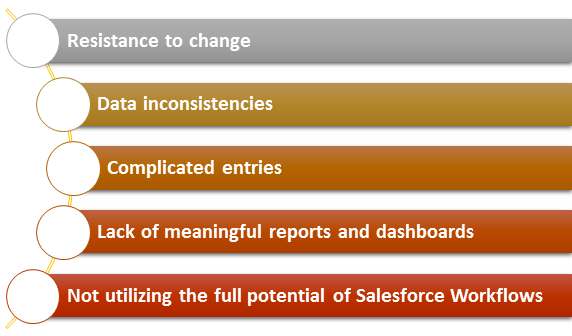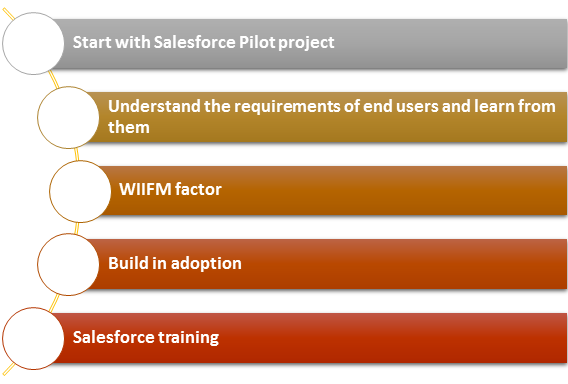Salesforce is a big name when it comes to CRM. Several organizations are making a shift to Salesforce because of their outstanding results, reviews, and recommendations. But let me tell you that implementing Salesforce is not going to be easy as it looks because it brings a cultural change in the organization and thus it creates user adoption problems. While implementing Salesforce in an organization, people forget to consider the aspects of user adoption which later can become a huge deal. In this blog, we shall cover the major salesforce user adoption problems along with the methods and techniques to tackle them.

“Habits are easy to make but hard to break,” this quote fits in this case perfectly. It is a usual sight to see resistance amongst employees to follow the newly implemented system. The issue heightens when your employees haven’t used Salesforce previously. It is important for the managers to dig deep into this issue and find the last longing solution. One must understand that this issue of resistance amongst user for adopting salesforce can’t be solved overnight. Most managers note either an absence of understanding, benefits and training as the reasons why users don’t adopt the salesforce at a faster rate. When you’re embracing a framework as large as Salesforce, you have to give abundant training and support to the users. This will de-escalate the issue of user adoption rate.
A ton of Salesforce users associate their CRM with different applications, which may hamper your data consistency. It’s recommended to utilize Salesforce as the focal center for all your data and match up different frameworks from that point. Old, obsolete and fragmented data not just drive sales representatives insane it likewise decreases the validity of your Salesforce framework and reports.
Unnecessary fields and long page layouts make it difficult for Salesforce users to work on it. One must focus on “Keeping it short and simple.” It is important to ensure that Salesforce users can collect data without any hassle. Long page layouts also frustrate the Salesforce users because of too much scrolling to capture any data. One must make a note that keeping too many fields also contributes to bad data.
Your salesforce contains a pool of data, and it can be utilized to generate meaningful reports and dashboards to develop strategies and plan. But if the generated reports are vague, the users lose interest, and thus the user adoption rate also reduces drastically.
One of the major mistakes the one does while implementing the salesforce is not utilizing the Salesforce Workflows. Salesforce workflows can help in increasing productivity by sending auto mailers to customers, renewal reminders, SLA agreements escalations, notification of stale lead and opportunities.

Whenever you are implementing a system, you must do a pilot test run on a group of users. In this way, you can perform the testing, identify the gaps, understand user’s requirements and practical issues. For the pilot run, you need to select a group of users and provide them with all the necessary training and materials needed to run the Salesforce effectively.
This is a critical step that one must keep in mind to successfully implement the Salesforce in an organization. One must discuss reports, dashboards, features, and functionalities with the employees in your sales team. Their viewpoint will enable you to streamline the salesforce configuration and its user adoption rate.
As already mentioned, people hesitate to change. Despite your several attempts to prove how salesforce can be beneficial for them, there will be people in your team with the same question, i.e. “what’s in it for me?”. For any appropriation or change management procedure, it’s ideal for moving slowly and considering it as a total people process. If not enunciated appropriately, there would be abhorrence for the thought, which will unfavorably reflect on the user adoption process. To train users, you will require different sessions to set the expectations, equip your workforce with reading materials such as user manuals, SOPs, etc. and stay up to date with the latest advancements of Salesforce.
Implementing Salesforce in an organization is commonly a long procedure. Contingent upon the size and spread of your association, it would effectively take at least six months to one year to effectively implement and execute the CRM. On the off chance that you are simply beginning with your Salesforce installation, at that point, there’s no better time to start your Salesforce user adoption strategy. You need to formulate the arrangement and set your expectations from the first day itself. Ensure that you focus on a strategy and Salesforce experience that is consistent for your workforce which fits all the requirements of the stakeholders. While you are busy in implementing the salesforce in the organization, make a point to include all the stakeholders through the procedure. User adoption is a people process, and you may require some solid voices on your side from top management to ensure your workforce notice your Salesforce user adoption plan.
To fast track the user adoption process, you must provide quality training so that they understand the basic idea behind implementing Salesforce and how it can be beneficial to them. For organizations and people who are not familiar with Salesforce, a step by step training is necessary so that they understand how to use it effectively and how to tackle any difficulties or errors that come into the picture. To impart training, you should think about five critical question
From the above discussion, it is quite evident that the success or failure of any new system in a workplace depends on the users. Higher user adoption is the key to achieve higher ROI. There is no doubt that user adoption is a time consuming, nerve-wracking and complex but on the other hand, it is one of the most important processes for successful implementation of Salesforce.
Stop, read and acquire deep insights into complex issues
© 2025 Copyright - JanBask.com | Designed by - JanBask Digital Design
Write a Comment